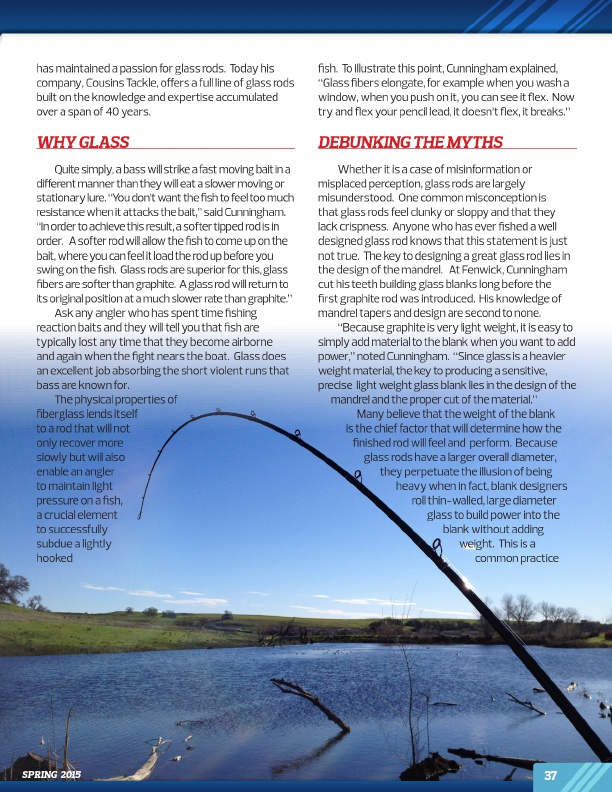
has maintained a passion for glass rods. Today his company, Cousins Tackle, offers a full line of glass rods built on the knowledge and expertise accumulated over a span of 40 years.
WHY GLASS
Quite simply, a bass will strike a fast moving bait in a different manner than they will eat a slower moving or stationary lure. “You don’t want the fish to feel too much resistance when it attacks the bait,” said Cunningham. “In order to achieve this result, a softer tipped rod is in order. A softer rod will allow the fish to come up on the bait, where you can feel it load the rod up before you swing on the fish. Glass rods are superior for this, glass fibers are softer than graphite. A glass rod will return to its original position at a much slower rate than graphite.”
Ask any angler who has spent time fishing reaction baits and they will tell you that fish are typically lost any time that they become airborne and again when the fight nears the boat. Glass does an excellent job absorbing the short violent runs that bass are known for.
The physical properties of fiberglass lends itself to a rod that will not only recover more slowly but will also enable an angler to maintain light pressure on a fish, a crucial element to successfully subdue a lightly hooked
fish. To illustrate this point, Cunningham explained, “Glass fibers elongate, for example when you wash a window, when you push on it, you can see it flex. Now try and flex your pencil lead, it doesn’t flex, it breaks.”
DEBUNKING THE MYTHS
Whether it is a case of misinformation or misplaced perception, glass rods are largely misunderstood. One common misconception is that glass rods feel clunky or sloppy and that they lack crispness. Anyone who has ever fished a well designed glass rod knows that this statement is just not true. The key to designing a great glass rod lies in the design of the mandrel. At Fenwick, Cunningham cut his teeth building glass blanks long before the first graphite rod was introduced. His knowledge of mandrel tapers and design are second to none.
“Because graphite is very light weight, it is easy to simply add material to the blank when you want to add power,” noted Cunningham. “Since glass is a heavier weight material, the key to producing a sensitive, precise light weight glass blank lies in the design of the
mandrel and the proper cut of the material.”
Many believe that the weight of the blank
is the chief factor that will determine how the
finished rod will feel and perform. Because
glass rods have a larger overall diameter,
they perpetuate the illusion of being
heavy when in fact, blank designers
roll thin-walled, large diameter
glass to build power into the
blank without adding
weight. This is a
common practice
SPRING 2015
37